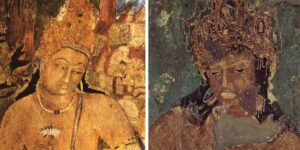In the early 20th century, a group of rebellious artists challenged conventional norms through their unconventional art movement known as Dadaism. In this article, we will explore the fascinating origins, key characteristics, and influential artists of Dadaism. So grab your imagination and let’s dive into this captivating art revolution!

Origins of Dadaism
Dadaism started a long time ago in Zurich, Switzerland, during a big war called World War I. The artists and thinkers of that time were upset with the world and wanted to do something different with their art. They gathered at a place called Cabaret Voltaire and made art that was silly and didn’t follow the usual rules. They used weird materials and techniques to show how strange and chaotic the world was. They wanted to make people think and question what art could be. Dadaism soon spread to other cities and became a big rebellion against the normal way of doing things.
Characteristics of Dadaism
Dadaism was characterized by its absurdity, spontaneity, and rejection of logic. The artists sought to disrupt and provoke, using unconventional materials and techniques to create thought-provoking works. Collage, photomontage, readymades (ordinary objects presented as art), and performance art were among the mediums favored by Dadaists. Their aim was to question the very nature of art and society, often through satirical and nonsensical means.
Influential Dadaist Artists
Marcel Duchamp: One of the most influential figures in Dadaism, Duchamp challenged the art world with his “readymades.” These were everyday objects, such as a urinal or a bicycle wheel, presented as works of art. Duchamp’s revolutionary approach questioned the role of the artist and the concept of originality.
Hannah Höch: As one of the few female Dadaists, Höch used photomontage to explore themes of gender, identity, and societal roles. Her works were visually striking and often contained sharp social commentary, defying the expectations imposed on women at the time.
Man Ray: Known for his experimental photography and involvement in the Dada and Surrealist movements, Man Ray blurred the lines between art and everyday objects. He created “Rayographs” by placing objects on photosensitive paper and exposing them to light, resulting in abstract and mysterious compositions.
Dadaism's Legacy and Influence
Dadaism had a big impact on the art world and continues to inspire artists even today. It changed the way people thought about art and what it could be. Let’s explore the legacy and influence of Dadaism in a way that is easy for young minds to understand.
First, Dadaism taught us that art doesn’t always have to make sense. The Dadaists created artwork that seemed strange and silly, using everyday objects in weird ways. They wanted to show that art could be playful and make people think in new and unexpected ways.
Dadaism also challenged the idea of what is considered “good” art. The Dadaists didn’t care about following the traditional rules of art. They wanted to break those rules and create something totally different. This idea opened the door for artists to be more creative and experiment with new ideas and materials.
The influence of Dadaism can be seen in many different art movements that came after it. For example, Surrealism was inspired by Dadaism and focused on dreams and the subconscious mind. Pop Art, another movement that became popular later on, celebrated everyday objects and consumer culture, just like the Dadaists did with their readymades.
Dadaism also showed us that art can be a way to express our feelings and opinions about the world. The Dadaists used their art to criticise society and the problems they saw. They wanted people to question the world around them and think about how things could be different.
Embracing Dadaism's Philosophy
Dadaism invites everyone, regardless of age, to embrace its philosophy of breaking free from constraints and embracing individual creativity. Young artists can draw inspiration from Dadaist principles by experimenting with different materials, questioning the world around them, and expressing their ideas through unconventional means.
Conclusion
In conclusion, Dadaism not only left a lasting impact on the art world but also paved the way for future artistic movements, such as Surrealism. The ideas and techniques explored by Dadaists directly influenced Surrealist artists who came after them.
Surrealism, which emerged in the 1920s, shared a similar rebellious spirit with Dadaism. Surrealist artists, like Salvador Dalí and René Magritte, were inspired by the Dadaists’ rejection of rationality and their focus on the subconscious mind. They sought to explore the dream-like and irrational aspects of human existence through their art.
Dadaism’s influence on Surrealism can be seen in the use of unexpected juxtapositions, dreamscapes, and symbolic imagery. Both movements embraced the idea of tapping into the unconscious mind to create art that challenges traditional norms and pushes the boundaries of imagination.
By breaking down the barriers between reality and the fantastical, Surrealism expanded on the foundations laid by Dadaism. It further encouraged artists to explore the depths of their creativity and delve into the realms of the subconscious.
In this way, Dadaism acted as a catalyst for Surrealism, providing a platform for artists to question reality, challenge artistic conventions, and delve into the mysterious realms of the mind. The legacy of Dadaism lives on through Surrealism and continues to inspire artists to this day.

